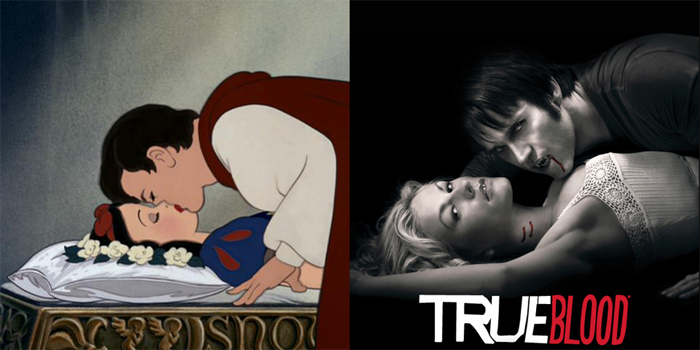My mother’s response to all-things-Vampire is, “Oh, gross. I don’t know how you like any of that stuff. It’s disgusting.”
 Whether or not you find sickly pale skin and lack of a heartbeat appalling or appealing, it appears that Vampires are all the rage right now. Other than just writing them off as dark imaginings for the purposes of entertainment, what’s really going on with the ever-increasing popularity of these creatures of the night is quite interesting. Somehow the story of Dracula has transformed into the popular Interview With the Vampire series and Buffy the Vampire Slayer, which paved the way for Angel and the global phenomenon of the Twilight saga, not to mention True Blood, V (those reptiles are total vampires!), The Vampire Diaries, The Gates, Underworld, and a seemingly endless stream of other movies, television shows and books that reflect these strangers of the night who can’t actually reflect themselves.
Whether or not you find sickly pale skin and lack of a heartbeat appalling or appealing, it appears that Vampires are all the rage right now. Other than just writing them off as dark imaginings for the purposes of entertainment, what’s really going on with the ever-increasing popularity of these creatures of the night is quite interesting. Somehow the story of Dracula has transformed into the popular Interview With the Vampire series and Buffy the Vampire Slayer, which paved the way for Angel and the global phenomenon of the Twilight saga, not to mention True Blood, V (those reptiles are total vampires!), The Vampire Diaries, The Gates, Underworld, and a seemingly endless stream of other movies, television shows and books that reflect these strangers of the night who can’t actually reflect themselves.
Vampires are creatures of intense desire who feed off human blood to survive, eventually draining their victims of all life. They sleep in coffins during the day, and can only come out at night because they happen to turn to ash when exposed to sunlight (although certain modern versions are more flexible with this bit). They glamour you with their fabulously alluring eyes before sinking their fangs into your neck for the first (and probably last) bite. They are warded off by sacred objects like holy water and crosses, and a nifty built-in safety feature for humans is that vampires can only enter your house by invitation. If you want a symbolic example of what happens if you innocently invite one in, check out Judi Dench in Notes On a Scandal and give yourself a gold star.
Taking these descriptors archetypally and looking at the state of the world right now, you might, if you’re so inclined, make a strong case that the United States invited a vampire presidential cabinet into our home (the White House) for eight years at the start of the 21st century. Now, issues regarding border security (boundaries) are almost a daily feature on the news.
Or you might consider that most of the modern vampire stories emerge from and are set in the South—arguably the “heart” of this country, that once lost a battle with the “head” of the North—perhaps as an outpouring of left-over residential ire of the Civil War.
You could even stretch it back to the founding of the United States altogether, with the Vampire as a symbol of the violently destructive forces that have single-handedly drained and decimated the Native American culture for the sake of survival. And, taking that into account while broadening our scope to the stronghold of Christianity over the last two thousand years of history, it’s probably worth noting that the holy communion is essentially symbolic of drinking someone's blood and eating a piece of their body. Communion and consummation, anyone?
And believe it or not, as the popularity of “Twilight” indicates, these dynamics apparently constitute the characteristics of modern romance! I guess it’s not too surprising amidst the ridiculously high number of marriages ending in messy divorces (I know a couple of people who seem to get married because they like the divorce process so much) and the challenge of redefining marriage in the modern era.
Interestingly enough, our cultural images of the romantic ideal have flip-flopped. The one-time image of a snowy white dead female is now replaced by a severely anemic, pasty white dead male.
Which brings me back to the fact that Vampires are, when all is said and done, dead. Dead. Cold. Lifeless. (I consider that a deal-breaker in relationships, but perhaps that's just me.)
One of my favorite ways of looking at the Vampire symbolically is through its connection to the past. See, vampires were human at one point; humans turned into vampires by another vampire. At the point when a human is turned, the human is dead. To see the person “alive” again is symbolic of our own desire to not only live in the past, but to take it to bed and sleep with it. Vampires are essentially an image of the past walking around on two legs and seducing you into living with it, turning your eyes away from the light of a new day, living an endless night, draining your own life force by living more in the past than in the present. Granted, the past can be very seductive. Romanticizing the past has a certain appeal: you survived it. Staring directly at an uncertain future can be not only troubling, but downright frightening. So frightening, in fact, that the false security of the past (“false” because it’s passed, it’s over) can seem positively luminous by comparison.
A good reminder in these times are the words from futuristic show Stargate SG-1, wisely imparted to Sam by Teal’c as she worried about stepping forward into her own uncertain future: “Draw from your past, but do not let your past draw from you.”
